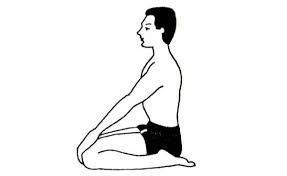Vajrasana (Thunderbolt Pose))

Description
Vajrasana, also known as Thunderbolt Pose, is a seated yoga posture that involves kneeling on the floor with the buttocks resting on the feet and heels touching the sides of the hips. This asana offers various physical and digestive benefits, making it an ideal posture for meditation and enhancing overall well-being.
Execution
- Kneel on the floor with the knees close together.
- Bring the big toes together and slightly separate the heels.
- Lower the buttocks onto the inside surface of the feet, with the heels touching the sides of the hips.
- Place your hands on your knees, palms facing down.
- Keep your back and head straight without tensing up.
- Relax your arms and the whole body.
- Breathe normally and direct your attention to the flow of breath passing in and out of the nostrils.
Duration
- For spiritual practice, vajrasana can be held for extended periods.
- A few minutes daily is sufficient to relieve tension in the legs.
- After meals, practice vajrasana for at least 5 minutes to aid digestion.
- If any strain is felt, stop the asana to avoid discomfort.
Awareness
- Physical: Focus on sensations in the legs, buttocks, and spine. Once comfortable in the pose, become aware of the natural breathing process. Practicing with closed eyes can enhance tranquility.
- Spiritual: Direct awareness to Manipura Chakra (solar plexus chakra).
Benefits
- Alters blood and nervous impulses in the pelvic region and strengthens pelvic muscles.
- Prevents hernia and provides relief from piles.
- Reduces blood flow to the genitals and massages related nerve fibers, benefiting conditions like varicose veins and hydrocele.
- Alleviates menstrual disorders.
- Enhances digestive efficiency, relieving stomach ailments such as hyperacidity and peptic ulcers.
- Ideal for meditation, as it naturally aligns the body upright without effort.
- Beneficial for people with sciatica.
- Stimulates vajra nadi, activates prana in sushumna, and redirects sexual energy for spiritual purposes.
Practice Note
- If there’s thigh pain, slightly separate the knees while maintaining the posture.
- Beginners may experience ankle discomfort; alleviate it by shaking the feet vigorously while seated with legs stretched forward before resuming the pose.
Note
- Vajrasana is used by Muslims and Zen Buddhists for prayer and meditation.
- For those who find padmasana or siddhasana uncomfortable, vajrasana can be a suitable alternative for meditation practice.
